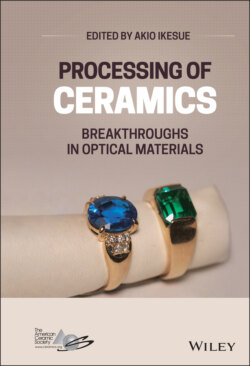Читать книгу Processing of Ceramics - Группа авторов - Страница 21
2.2.2 Stimulated Emission and Laser Generation
ОглавлениеAs described above, fluorescence can be generated at four levels or three levels, but this fluorescence is merely a spontaneous emission phenomenon. LASER stands for “Light amplification by stimulated emission of radiation,” so it is necessary to understand how stimulated emission and light amplification are performed. When a laser gain medium is irradiated with a white light (flash lamp), electrons present in the laser element are brought into an excited state to generate fluorescence (spontaneous emission). As shown in Figure 2.2a, if a reflecting mirror (100% reflection) and an output mirror (reflectance 98–90%) are provided on the opposite surfaces of the laser gain medium (both ends are optically polished), spontaneous emission in random directions will occur. A part of the spontaneous emission light has directionality (that is, reciprocal reflection toward mirrors installed at both ends), and when the excitation light is irradiated from the outside, the spontaneous emission light propagates in the same direction in conjunction with the direction of excitation light as shown in Figure 2.2b. The propagation probability increases further, and finally, as shown in Figure 2.2c, most of the spontaneous emission light becomes stimulated emission light in the same direction and phase inside the resonator. Amplification of stimulated emission light is repeated in the resonator. In order to obtain laser oscillation, the population inversion [N2 (the number of electrons in the upper level) > N1 (the number of electrons in the lower level)] of the laser active element passes through the output mirror when the intensity reaches a certain level. The resulting coherent light is called a laser. For laser oscillation, when the population inversion condition [N2 (the number of electrons in the upper level) > N1 (the number of electrons in the lower level)] of the laser active element reaches a certain level, coherent light comes out through the output mirror, and this artificial light is called laser.
The laser has oscillation modes such as continuous‐wave (cw) oscillation and pulse oscillation, and it is also necessary to know about transverse mode (beam shape) and longitudinal mode (wavelength) indicating the coherency of the laser. However, since the purpose of this book is material science, we omit this part. The principle of laser generation is described above. To obtain laser light, coherence light is amplified inside a solid (single crystal, glass, ceramics). Therefore, the laser gain medium must have specifications such as follows: (i) minimum optical loss (ideally, scattering and absorption are zero), (ii) the same refractive index in all regions (no composition fluctuation inside the material), and (iii) no birefringence (no distortion or secondary phase). Therefore, it is not too much to say that the required optical quality level for the laser material is “ultimate and ideal optical material.” Glass is the most suitable material in terms of optical quality level, but its drawback is low thermal conductivity. In view of the problem of heat generation inevitable during laser oscillation and the overall characteristics, single crystals are produced by the melt‐growth method. What is a material that has properties more excellent than a single crystal and will support laser science in the future? The answer is “ceramics” which have been considered unsuitable as optical materials until now.
Figure 2.2 Light amplification by stimulated emission of radiation in the optical resonator. (a) Spontaneous emission and the starting point of radiation. (b) Middle step of stimulated emission. (c) Amplification in resonator and laser emission.
